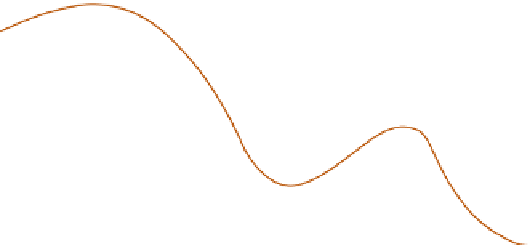Geoscience Reference
In-Depth Information
120°E
140°E
160°E
180°
160°W
H
H
30°N
Midway
L
Marcus
Honolulu
Manilla
L
Wake
Saipan
Johnston
L
Guam
Yap
Polau
Eniwetok
Kwajalein
Truk
0°
H
Figure 11.7
The surface synoptic chart for part of the northwest Pacific on 17 August 1957. The movements of
the central wave trough and of the closed circulation during the following 24 hours are shown by the dashed line and
arrow, respectively. The dashed L just east of Saipan indicates the location in which another low pressure system
subsequently developed.
Source: From Malkus and Riehl (1964). By permission of the University of California Press.
next 24 hours. A well-developed wave was evident
near Wake Island, having spectacular cumulus
towers extending above 9km along the conver-
gence zone some 480km east of it. This wave
developed within 48 hours into a circular tropical
storm with winds up to 20m s
-1
, but not into a full
hurricane. A strong, closed circulation situated
east of the Philippines moved northwestward.
Equatorial waves may form on both sides of the
equator in an easterly current located between
about 5
each year are responsible, on average, for 20,000
fatalities, as well as causing immense damage
to property and a serious shipping hazard, due to
the combined effects of high winds, high seas,
flooding from the heavy rainfall and coastal storm
surges. Considerable attention has been given to
forecasting their development and movement, so
their origin and structure are beginning to be
understood. Naturally, the catastrophic force of a
hurricane makes it a very difficult phenomenon to
investigate, but information is obtained from
aircraft reconnaissance flights sent out during the
'hurricane season', from radar observations of
cloud and precipitation structure (
Plate 11.1
), and
from satellite data.
The typical hurricane system has a diameter of
about 650km, less than half that of a mid-latitude
depression, although typhoons in the western
Pacific are often much larger. The central pressure
at sea level is commonly 950mb and exceptionally
falls below 900mb. Named tropical storms are
those defined as having one-minute average wind
velocities of at least 18m s
-1
at the surface. If these
winds intensify to at least 33m s
-1
, the named
storm becomes a tropical cyclone. Five hurricane
N and S. In such cases, divergence ahead
of a trough in the Northern Hemisphere is paired
with convergence behind a trough line located
further to the west in the Southern Hemisphere.
The reader may confirm that this should be so by
applying the equation for the conservation of
potential vorticity, remembering that both f and
ζ
°
operate in the reverse sense in the Southern
Hemisphere.
2
Cyclones
Hurricanes and typhoons
The most notorious type of cyclone is the
hurricane (or typhoon). Some 90 or so cyclones





















































































































